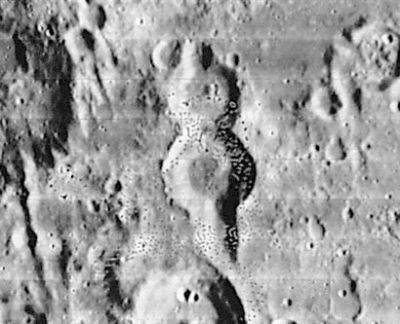Vogel
Contents
Vogel
|
Lat: 15.1°S, Long: 5.9°E, Diam: 26 km, Depth: 2.4 km, Rükl: 56 |
Images
LPOD Photo Gallery Lunar Orbiter Images Apollo Images
- Vogel was also captured on several frames made by Apollo 16's south-looking mapping/metric Fairchild camera, such as frame AS16-M-0707, in which the curious system of craters (called Vogel) is noticeable a little bit below and to the left of the frame's centre.
- Research: Danny Caes.
Maps
(LAC zone 77C3)LAC map Geologic map LM map
Description
Description: Wikipedia
Additional Information
- Depth data from Kurt Fisher database
- Westfall, 2000: 2.4 km
- Viscardy, 1985: 2.78 km
- Central peak height
- Sekiguchi, 1972: 0.5 km - fatastronomer
Nomenclature
- Named for Hermann Carl Vogel (April 3, 1841 – August 13, 1907). a German astronomer. He was one of the pioneers of the use of the spectroscope in astronomy, and used this instrument to analyze the atmospheres of the planets in the solar system. He was the first to determine the Suns rotation period through Doppler shift. By obtaining periodic Doppler shifts in the components of Algol he proved it to be a binary star; thus, Algol was one of the first known spectroscopic binaries (and of course it is in fact an eclipsing binary). Vogel was the 1906 Bruce Medalist of the Astronomical Society of the Pacific and extensive links to information about him can be found there.
- This feature was Catalog number 3560 in Mary Blagg's Collated List. It was called Airy d by Beer and Mädler and by Julius Schmidt, but Argelander d in Neison, 1876.
- The name Vogel was selected for use in the original IAU nomenclature of Named Lunar Formations, adopting a proposal attributed to Krieger.
- Perhaps interesting to know that there was also a Hermann Wilhelm Vogel (1834-1898; German photochemist and photographer who made key contributions to practical color photography).- DannyCaes Nov 28, 2010
LPOD Articles
Bibliography
H. C. Vogel is mentioned on page 249 of Burnham's Celestial Handbook (Volume 1), because he discovered the star Beta Arietis to be a spectroscopic binary. - DannyCaes Apr 30, 2015
A certain E. Vogel in the Sourcebook Project (William R. Corliss)
According to page 574 in the book Mysterious Universe, a handbook of astronomical anomalies (1979), there seems to have been a certain E. Vogel who observed the optical illusion of "Jumping Stars" (see article Jumping Stars, Observatory, 1888).
